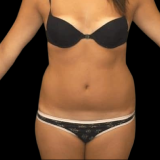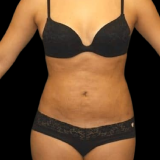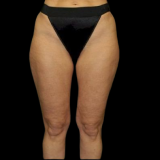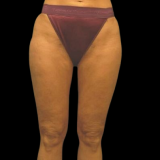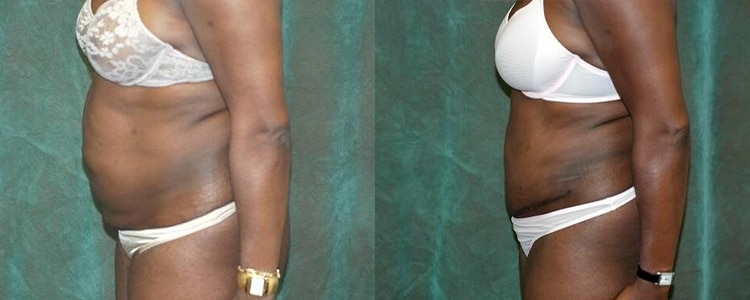Contents
Introduction
Are you contemplating abdominoplasty in Washington DC to achieve a flat and toned midsection? Also known as a tummy tuck, this procedure helps eliminate stubborn fat and loose skin, giving you a contoured abdomen when diet and exercise fall short. Before diving into the details, here’s a quick rundown to address your immediate concerns:
- What is Abdominoplasty? It’s a surgical procedure to remove excess skin and fat and tighten abdominal muscles.
- Is it a Weight Loss Solution? No, it’s for contouring, not for losing weight.
- Costs and Insurance: Generally, costs are variable and not covered by insurance.
- Recovery Time: Expect to return to work within 2 to 6 weeks.
Many factors, including aging, pregnancy, weight gain, and genetics, can affect abdominal appearance. If you’re in the Washington, DC area, including Fairfax, Arlington, and Alexandria, our guide will help you make an informed decision about getting a tummy tuck.
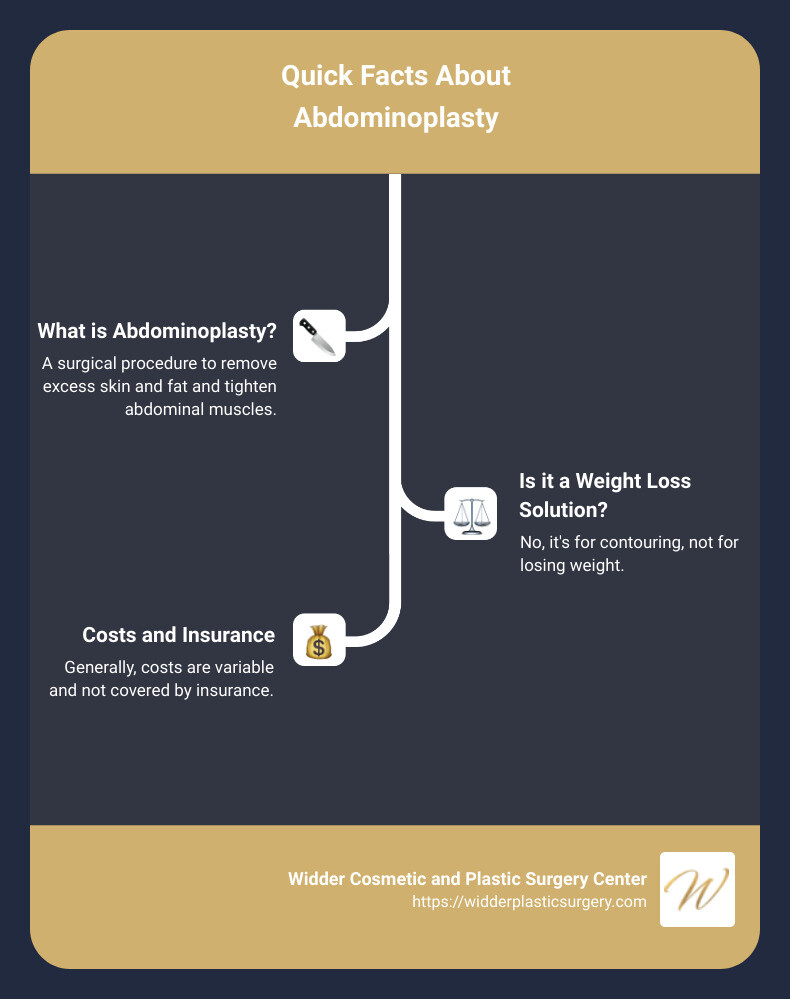
In this guide, we’ll explore everything you need to know about abdominoplasty, from choosing the right surgeon to understanding the costs and recovery process. Let’s get started!
Understanding Abdominoplasty
When it comes to transforming your midsection, understanding the differences between a tummy tuck and abdominoplasty is crucial. These terms are often used interchangeably, but they have specific meanings.
Tummy Tuck vs. Abdominoplasty
Tummy Tuck is a common term for abdominoplasty, a surgical procedure aimed at giving your abdominal area a more contoured and toned appearance. While both terms refer to the same surgery, “tummy tuck” is more colloquial and widely recognized.
Excess Skin
One of the main reasons people opt for abdominoplasty is to remove excess skin. This issue often arises from significant weight loss, pregnancy, or aging. Loose skin can be difficult to manage with diet and exercise alone.
Example: Jane, a mother of two from Alexandria, struggled with loose skin after her pregnancies. Despite working out regularly, she couldn’t achieve the flat stomach she desired. After her abdominoplasty, she felt more confident and comfortable in her own skin.
Fat Deposits
Another challenge is stubborn fat deposits, especially subcutaneous fat, which lies just under the skin. This type of fat is notoriously hard to eliminate through conventional weight loss methods.
Fact: According to Dr. John R. Barbour, a tummy tuck is not a weight-loss surgery but rather a way to remove fat that is resistant to diet and exercise.
Muscle Tissue
Abdominoplasty also addresses the underlying muscle tissue. Over time, or due to events like pregnancy, the abdominal muscles can become stretched or separated. This condition, known as diastasis recti, can only be corrected surgically.
Case Study: After her second pregnancy, Maria from Fairfax noticed a persistent bulge in her abdomen. Despite her best efforts, she couldn’t get rid of it. Her surgeon explained that her abdominal muscles had separated, and a tummy tuck could restore them. Post-surgery, Maria saw a significant improvement in her abdominal contour.
Types of Abdominoplasty
There are different approaches to abdominoplasty, each tailored to specific needs:
- Full Tummy Tuck: This involves a long incision from hip to hip and addresses both the upper and lower abdomen. The belly button may also be repositioned.
- Mini Tummy Tuck: This is less extensive and focuses on the area below the belly button. Ideal for those with minimal skin and muscle laxity.
- Modified Tummy Tuck: This technique targets either skin laxity or muscle weakness, not both. It offers subtle improvements without the need for extensive surgery.
Each type of abdominoplasty is designed to meet different cosmetic goals, so discuss your options with a qualified surgeon.
In the next section, we’ll guide you through choosing the right surgeon for your abdominoplasty in Washington, DC.
Choosing the Right Surgeon
Choosing the right surgeon is crucial for a successful abdominoplasty in Washington, DC. Here’s what you need to know:
Board Certification
Ensure your surgeon is board-certified. Board certification means the surgeon has undergone rigorous training and has passed extensive exams. It’s a mark of quality and trust. At Widder Cosmetic and Plastic Surgery Center, our surgeons are all board-certified, ensuring you receive top-notch care.
Experience
Experience matters. Our surgeons at Widder Cosmetic and Plastic Surgery Center have performed numerous abdominoplasties, making them highly skilled in various techniques and capable of handling any complications that might arise.
Patient Reviews
Patient reviews can provide valuable insights. Look for reviews on our website and other independent platforms. Positive reviews about our surgeons’ bedside manner, the facility, and the overall experience can give you confidence in your choice.
Before and After Photos
Before and after photos are essential. They show the skill of our surgeons and the results you can expect. Make sure to view our gallery of before and after photos of patients who had similar body types and goals as you. This will give you a realistic idea of what your results might look like.
Cost of Abdominoplasty in Washington DC
When considering abdominoplasty in Washington DC, understanding the costs is crucial. Here’s a breakdown of what you can expect:
Starting Costs
The cost of a tummy tuck at Widder Cosmetic and Plastic Surgery Center typically starts at around $10,500. This figure can vary based on the specifics of your procedure and the extent of the treatment needed to achieve your desired results.
Factors Affecting Price
Several factors can influence the overall cost of your abdominoplasty:
- Type of Procedure: A full tummy tuck generally costs more than a mini tummy tuck due to the extent of work involved.
- Surgeon’s Experience: Our board-certified surgeons with extensive experience ensure better results and a safer procedure.
- Geographical Location: Being located in an urban area like Washington DC, our costs reflect the high standard of care provided.
- Additional Procedures: Combining a tummy tuck with other procedures can increase the overall cost.
Consultation Fees
Before your surgery, you’ll have a consultation with your surgeon. Consultation fees at our center are typically $100 to $300. This fee is applied towards the total cost of your surgery if you decide to proceed.
Financing Options
We understand that abdominoplasty can be a significant financial commitment. Widder Cosmetic and Plastic Surgery Center offers financing options like CareCredit® and Alphaeon® to provide flexible payment plans, making the procedure more accessible.
Preparing for Your Abdominoplasty
BMI Requirements
Before undergoing abdominoplasty in Washington DC, your Body Mass Index (BMI) needs to be within a specific range. Most surgeons prefer a BMI under 30 to minimize risks and ensure better results. A higher BMI can increase the risk of complications such as poor wound healing and infection.
If your BMI is above the recommended range, your surgeon might advise you to lose weight before proceeding with the surgery. This is not only for safety but also to help achieve the best possible outcome.
Smoking Cessation
If you’re a smoker, it’s crucial to quit smoking several weeks before your surgery. Smoking can significantly impede the healing process and increase the risk of complications like poor wound healing and infection. Most surgeons recommend stopping smoking at least 4-6 weeks before and after the procedure.
Nicotine constricts blood vessels, reducing blood flow to the skin and tissues, which is essential for proper healing. If quitting smoking is challenging, talk to your doctor about resources to help you stop.
Pre-Surgery Consultation
Your pre-surgery consultation is a vital step in preparing for your abdominoplasty. During this meeting, you’ll discuss your medical history, current medications, and any concerns you have about the procedure. This is also the time to ask questions and understand what to expect.
The surgeon will perform a detailed examination of your abdomen to determine the best surgical approach. They will explain the procedure, potential risks, and expected outcomes. This consultation helps ensure you are a good candidate for the surgery and that your expectations are realistic.
Medical Tests
Before your surgery, you will need to undergo several medical tests to ensure you are in good health. These tests might include:
- Blood tests to check for any underlying conditions.
- Electrocardiogram (EKG) if you have a history of heart issues.
- Imaging tests like ultrasound, if necessary, to assess the abdominal area.
Your surgeon will provide a list of required tests during your consultation. Completing these tests helps identify any potential risks and ensures you are fit for surgery.
In the next section, we’ll cover what to expect during recovery and aftercare, including wearing support garments, managing pain, and activity restrictions.
Recovery and Aftercare
Support Garments
After your abdominoplasty in Washington DC, you’ll need to wear a compression garment. This garment helps reduce swelling, supports healing tissues, and contours your body to its new shape. Typically, you’ll wear it for about two weeks, but follow your surgeon’s guidelines for best results.
Drainage Tubes
Drainage tubes are often placed during surgery to catch any excess fluid. These tubes help prevent complications like fluid buildup and infection. Your surgeon will show you how to care for them, and they are usually removed at your first follow-up visit.
Pain Management
It’s normal to experience discomfort and soreness after surgery. Your surgeon will prescribe pain relievers to help manage this. Over-the-counter medications like acetaminophen can also be used, but avoid aspirin or ibuprofen unless approved by your doctor, as they can increase bleeding.
Activity Restrictions
For the first few weeks, avoid strenuous activities like heavy lifting, running, or intense workouts. Light walking is encouraged soon after surgery to promote blood circulation and prevent blood clots. Your doctor will give you the green light when it’s safe to resume more intense activities, usually around the four to six-week mark.
Follow-up Visits
Follow-up visits are crucial for monitoring your healing progress. Your first visit will likely be within a week after your procedure. During these appointments, your surgeon will check your recovery, address any concerns, and remove any stitches if necessary. These visits are your chance to ask questions and get professional advice on handling your recovery phase.
By adhering to these guidelines, you can ensure a smoother recovery and enjoy the best possible results from your abdominoplasty. Healing takes time, so be patient with your body and give it the care it needs.
In the next section, we’ll address some frequently asked questions about abdominoplasty, including insurance coverage and BMI requirements.
Frequently Asked Questions about Abdominoplasty
Is abdominoplasty covered by insurance?
In most cases, abdominoplasty is considered a cosmetic procedure and is not covered by insurance. However, there are exceptions. If you have significant excess skin that causes recurrent infections or other medical issues, your insurance may cover a portion of the procedure known as a panniculectomy. It’s always best to discuss your specific situation with your insurance carrier to understand what may be covered.
What is the BMI cut off for abdominoplasty?
Most surgeons recommend having a BMI below 30 for optimal results and to reduce the risk of complications. Some surgeons might perform the procedure on patients with a BMI up to 35, but this is less common and usually depends on individual health conditions and the surgeon’s discretion. Maintaining a stable weight before surgery is crucial for the best outcome.
How long is the recovery period?
Recovery from abdominoplasty generally takes several weeks. Here’s a quick breakdown:
First few days: You’ll need to rest and limit your activities. Pain and swelling are common, and you’ll likely have drainage tubes to help remove excess fluid.
2 to 6 weeks: Most people can return to work or school, provided their job isn’t strenuous. You can start driving within this period if you feel no pain in the abdominal area.
6 to 8 weeks: Strenuous activities and exercise can usually be resumed, depending on your comfort level and your surgeon’s advice.
Up to 12 months: Complete healing can take up to a year. During this time, scars will fade and swelling will gradually reduce.
First few days: You’ll need to rest and limit your activities. Pain and swelling are common, and you’ll likely have drainage tubes to help remove excess fluid.
2 to 6 weeks: Most people can return to work or school, provided their job isn’t strenuous. You can start driving within this period if you feel no pain in the abdominal area.
6 to 8 weeks: Strenuous activities and exercise can usually be resumed, depending on your comfort level and your surgeon’s advice.
Up to 12 months: Complete healing can take up to a year. During this time, scars will fade and swelling will gradually reduce.
By following your surgeon’s post-operative instructions, you can ensure a smoother recovery and achieve the best possible results.
In the next section, we’ll discuss how to choose the right surgeon for your abdominoplasty in Washington, DC, and what factors to consider during your search.
Conclusion
Choosing to undergo abdominoplasty in Washington DC is a significant decision, and we understand the importance of personalized care throughout your journey. At Widder Cosmetic and Plastic Surgery Center, our approach is tailored to meet your unique needs and aesthetic goals.
Personalized Care
We believe that each patient is unique and deserves a customized treatment plan. From your initial consultation to your final follow-up, our team ensures that every aspect of your care is designed specifically for you. This bespoke approach helps achieve results that not only meet but often exceed expectations.
Experience You Can Trust
Our team of board-certified surgeons, led by Dr. Shlomo Widder, brings decades of combined experience in plastic surgery. Dr. Widder, known affectionately as the “D.C. Butt Doctor,” has been a trusted name in the field for over 30 years. This wealth of experience ensures that you are in safe and skilled hands.
Comprehensive Care
Beyond abdominoplasty, Widder Cosmetic and Plastic Surgery Center offers a wide range of cosmetic procedures. Whether you’re looking for facial rejuvenation, breast enhancement, or body contouring, we have the expertise and technology to fulfill your needs. Our ability to offer multiple procedures under one roof makes it convenient for patients to address various aesthetic goals.
Commitment to Excellence
Safety, excellence, and patient satisfaction are at the heart of everything we do. Our commitment to these values sets us apart in a city renowned for its high standards in healthcare services. We take the time to listen, understand your desires, and guide you through every step of the process.
For more information on how we can help you achieve your aesthetic goals, explore our abdominoplasty services and take the first step towards a new you.
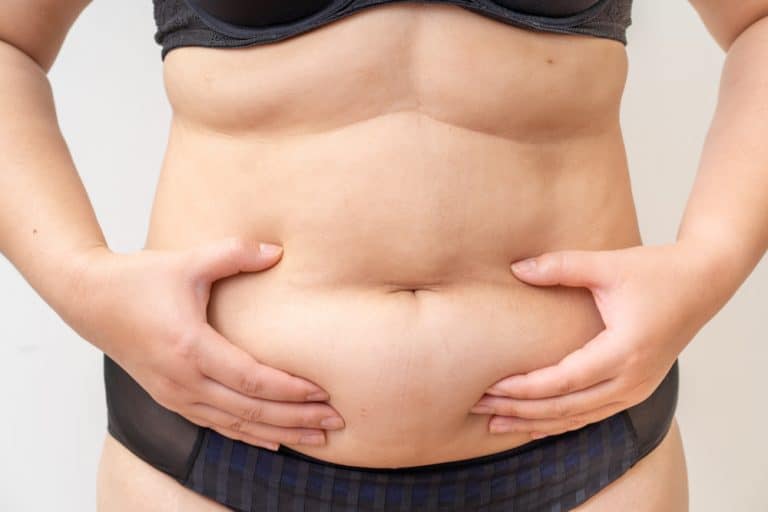
Thank you for considering Widder Cosmetic and Plastic Surgery Center for your abdominoplasty in Washington DC. We look forward to helping you achieve the sculpted, more youthful profile you desire.
